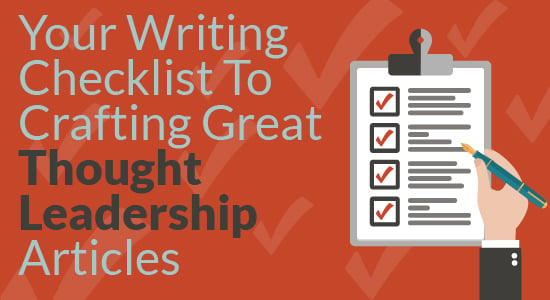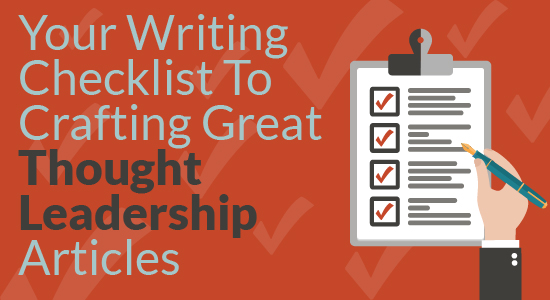Your Writing Checklist To Crafting Great Thought Leadership Articles

Thought leadership may be a more powerful tool in your marketing arsenal than you realize, and it pays to ensure the quality of the bylined contributed articles you create is the best reflection possible of your company.
According to research from LinkedIn and Edelman, B2B decision makers say that strong thought leadership content not only strengthens a company’s reputation, but also positively impacts RFP invitations, wins, pricing and cross-selling that occurs post-sale. Yet only 17 percent of those respondents rate the quality of most of the thought leadership they read as good or excellent.
That means you have the opportunity to stand head and shoulders above the crowd when you focus on creating high quality thought leadership content to support your overall marketing and public relations strategy.
We’ve been helping our clients craft thought leadership articles and earning placement in industry publications for more than decade, with many editors learning to trust that the content we send will be a valuable addition for their readers.
(You can see some of our work and results in this blog post—Q&A: How JONES and West Use Contributed Articles in Marketing Campaigns—or by downloading an example of a complete integrated marketing campaign that uses thought leadership to support the rest of the campaign materials.)
Great thought leadership material doesn’t just magically appear, though. It takes talented, dedicated writers who understand that their job in this case is not to blatantly promote, but to educate and provide value.
The following checklist can help you guide your team through the process and deliver thought leadership material that exceeds the expectations of those decision makers who are reading it.
Review expectations.
Before beginning, make sure writers and project managers, whether in-house, freelance or agency staff, have a full understanding of the expectations of both your company and the publication that has accepted a pitch for a thought leadership article. (More on the process of pitching thought leadership articles and guest blog posts here.)
Steps writers should check off for this part of the process:
- Review the abstract or pitch given to the publication editor.
- Review all emails relevant to the assignment.
- Review submission guidelines for the publication.
- Review recently published articles for the publication to understand style, content, and tone of current content.
- Research the publication’s audience to understand the readership.
By understanding the audience, the tone, guidelines such as article length and preferred style guide before they start typing, writers will save time having to make adjustments to the article later.
Plan the content of the thought leadership article.
Chances are the content of the article has already been at least broadly outline in the pitch and abstract, and if done correctly, it should mesh with other marketing content being developed for the same campaign. (This post explains how to use abstracts in planning your complete marketing campaigns—not just for thought leadership article placement.)
If the writer of the thought leadership article wasn’t part of that initial planning, these steps are essential to getting up to speed.
- Develop one main message for the article to address.
- Develop a strong and clear position on the topic that is representative of your brand.
- Identify what is new, useful, or counterintuitive about your position that will interest readers.
- Logically outline the supporting points and examples to include.
Research the topic and gather relevant data.
One of the key elements in any thought leadership article is the valuable information it provides, which typically includes data and an interpretation of what that data means for the audience. We encourage clients to gather original data of their own that readers won’t find anywhere else. (See how that data fuels not only thought leadership articles, but up to 100 different pieces of marketing and PR content from a single survey: Maximizing Marketing Surveys.)
Check off these tasks as you gather the information you will use in the article.
- Review existing internal data and information to include in the article.
- Select relevant talking points from key products, initiatives or projects to leverage where appropriate.
- Complete any needed additional research (industry research, interviews of internal staff or external experts, polls of clients, etc.) before drafting an article.
Write for readers and for SEO.
Even though you are writing a thought leadership article that will appear in a publication, not on your own website, both reader usability and SEO are important in helping your content reach the widest possible audience. Writing for the reader (and for the editor of the publication to whom you pitched the article) is your top priority, but if you follow basic SEO best practices, both your brand and the publication benefit from the increased exposure.
General SEO tips to follow
- Include keywords or phrases that searchers might use to find this information.
- Do not “stuff” the article with keywords, but do use them in headlines and subheads as appropriate.
Write the right headline.
- Examine the publication’s current headlines to determine the preferred format and write a headline that matches that format.
- Select at least one keyword and include it in the headline.
- Limit headlines to 10 or fewer words.
- Follow the same capitalization for headlines and subheads as the publication uses in other articles.
- Incorporate subheads to break up text and allow readers to scan text to find key points.
Write an introduction that pulls readers in.
- Use the introduction to set up the topic and compel the audience to continue reading.
- Make the introduction relevant to the target audience.
- Ensure the overall message comes across in the introduction.
Provide valuable information in the main body.
- Develop copy around at least three key points or tips.
- Include at least one sourced statistic in the text.
- Include two to three links to additional information, with at least one link to company initiatives.
- Use subheads and a limited number of bulleted lists to visually organize information for readers. (Note: Some publications consider bulleted lists to be too much like brand talking points and frown on them. Use them sparingly and only when appropriate.)
- Use language that the target audience uses—avoid excessive jargon.
- Organize the text into small paragraphs of no more than 150-200 words.
Close the article with summary and author’s bio.
While a thought leadership article will not have the same kind of promotional call-to-action you might use in the closing of a post for your corporate blog, you should still focus on ending it in ways that provide opportunities for a reader to learn more about your business.
- Include a conclusion that summarizes the key takeaways.
- Close the article with an informational note, not promotional copy.
- At the end of the article, include the name, title, company and two- to three-line biography of the contributor that highlights the background and expertise of the author.
- Include links in the bio to the author’s page on the company website or another relevant social media site, such as LinkedIn.
Complete final edits and submit to publication.
These final steps might involve more than just the writer. Even fantastic writers can benefit from having a second set of eyes review their work and see it from a different perspective. Ensure that you can answer yes to all of these questions:
- Does the copy meet all publication style requirements?
- Does the article come across as informational rather than promotional?
- Does the article leverage the company’s unique point of view, insight, data, research, and expertise?
- Does the article address the publication’s audience and its needs?
- Is the article free of grammatical and spelling errors?
- Is the same verb tense used consistently throughout the copy?
- Is the copy written in a tone that is professional and conversational?
- Does the copy meet the word count requirements for the assignment?
- Are all statistics and information credited correctly?
- Do all links in the article work correctly?
This may seem like a lot of individual items to check off, but when writers, PR pros and marketers handle all of the details correctly when creating thought leadership articles to contribute to industry publications, the benefits they reap are worth the time.
Looking again at the results of the Edelman/LinkedIn survey, nearly half of business decision makers who engage with thought leadership material say they spend at least an hour a week doing so, and that same portion say that thought leadership material has an impact on their decision to make a purchase. Nearly 9 in 10 say it impacts their impression of an organization.
Consider these figures also:
- 59 percent of decision makers agree an organization’s thought leadership is a more trustworthy basis for assessing its capabilities than its marketing materials.
- 69 percent agree that reading thought leadership materials is one of the best ways to get a sense of the type and caliber of an organization’s thinking.
Are you ready to add thought leadership and contributed bylined articles into your integrated marketing and PR strategy? Download How To Get Your CEO Published for five steps to pitching, writing and promoting thought leadership content in ways that support the rest of your marketing strategy. You can also request a no-obligation consultation by scheduling time in my calendar. I’d be glad to talk over your options and how to begin a thought leadership campaign that drives both reputation and sales.
-1.png?width=1652&height=294&name=Jones(RGB)-1.png)








.png?width=352&name=jones_headerblogimage_feb.29.2020(2).png)

.jpg?width=352&name=Client%20Success_%20Complete%20Content%20Packages%20Fuel%20West%20Marketing%20Strategy%20(1).jpg)

